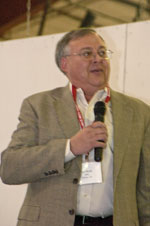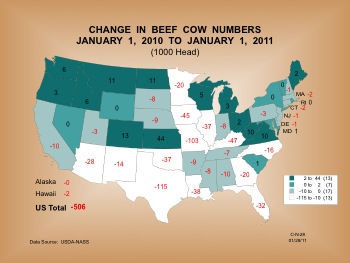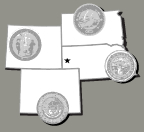Cow Inventory Presents Opportunity
by Kindra Gordon for Angus Productions Inc.
MITCHELL, Neb. (Nov. 29, 2011) — “There is a heck of an opportunity to make money in this business like we haven’t seen in a long time,” Jim Robb told cow-calf producers as he addressed attendees at the 22nd Range Beef Cow Symposium in Mitchell, Neb., Nov. 29. Robb is director of the Denver-based Livestock Marketing Information Center (LMIC).

Calf prices have been volatile, LMIC's Jim Robb said, adding that he anticipates record-high prices ahead, which will put cow-calf producers in the driver’s seat.Robb noted that there are several external factors influencing the industry, but despite the recent recession, he is optimistic for beef’s future.
The 2008-2009 recession was the worst economic recession since the Great Depression, he said. “Things have changed in the consumer picture. People used to brag about their spending and debt. Now, they have cut up their credit cards and become astute buyers.”
“People are saving more and not spending as much,” he added. “Things have changed; that’s a reality.”
But, Robb added, the economy is slowly recovering. And, for the economy’s big picture, he pointed to global factors.
“There will be one-third more people by 2050,” Robb said, noting that India and China will be the top two countries in world population, with the United States being third. “To meet the basic needs plus the growing incomes of this increased population, animal based product consumption will double by 2050.”
“That makes one more optimistic,” he said, adding, “We’ll need more of everything. We’ll need more grain and fertilizer to produce more animal protein, and we will need to do it more efficiently.”
 Currently, the United States is the largest beef-producing country in the world, Robb said. “That’s a pretty good position to be in. We don’t have the largest cow herd, but the U.S. does produce the most beef. So the window of opportunity is pretty good for the U.S.”
Currently, the United States is the largest beef-producing country in the world, Robb said. “That’s a pretty good position to be in. We don’t have the largest cow herd, but the U.S. does produce the most beef. So the window of opportunity is pretty good for the U.S.”
Globally, Robb shared that the cow herds in Mexico, Argentina and Russia are still shrinking, while the cattle inventories in Canada and Australia are beginning to stabilize.
Robb said projections for the U.S. cow herd inventory are 30 million head on Jan. 1, 2012, which is down 1.6% from a year ago. He called the drought in the South a “game changer” that has contributed to this declining inventory, while the high crop prices have also influenced inventory.
Specifically, Robb said, “Heifers held as beef cow replacements on July 1 were down 4.5% from a year ago … and cow slaughter has been huge. We need to add 300,000 head to stabilize the U.S. herd, and even more than that to grow it.”
Based on these trends, Robb said, “This is not the cyclical industry it was 10, 20 or 30 years ago. The beef cycle is still in a downward trend.”
He added, “Historically, many producers made management plans by where we were in the cattle cycle. The cycle is still here, but it is not the economic driver it was. It’s time to bury the cattle cycle.”
The nation’s cow herd is declining, and that trend will probably continue in 2012, Robb noted. “This means 2015 is the first opportunity to increase beef production in the U.S.”
Going forward, Robb noted that calf prices have been volatile, but he anticipates record-high prices ahead, which will put cow-calf producers in the driver’s seat. He noted that heavy steers and cull cows are also setting new highs.
Because of the low inventory and the increasing demand — especially globally — Robb said he anticipates the cost of replacement cows and bulls will increase — possibly by as much as $500 per cow-calf pair in the next year.
“Looking ahead, cow-calf returns are very positive, but you need to forget the cattle cycle,” Robb concluded. “Sound business practices will be required and mistakes could be costly. Cattle producers who are adaptable and flexible can make money.”
The biennial Range Beef Cow Symposium was hosted Nov. 29-Dec. 1 at the Mitchell Events Center, Mitchell, Neb., by the cooperative extension and animal science departments of the University of Nebraska-Lincoln, South Dakota State University, Colorado State University and the University of Wyoming. Comprehensive coverage of the event is provided online at www.rangebeefcow.com, an event coverage site provided by Angus Productions Inc. (API), publisher of the Angus Journal and the Angus Beef Bulletin.
Editor’s Note: API's coverage of the event is made available for distribution to all media via an agreement with the Range Beef Cow Symposium Committee and API. Headquartered in Saint Joseph, Mo., API publishes the Angus Journal, the Angus Beef Bulletin, the Angus Beef Bulletin EXTRA, and the Angus e-List, as well as providing online coverage of events and topics pertinent to cattlemen through the API Virtual Library. For questions about this site, or to notifiy us of broken links, click here.

